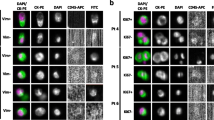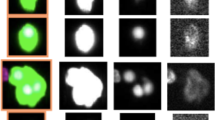Abstract
Bivariate flow cytometric analysis of proliferating cell nuclear antigen (PCNA) was performed on prostate carcinoma cell lines (PC-3, DU-145). For both cell lines 100% methanol fixation provided optimal fluorescence intensity of PCNA. The ratio of PCNA/DNA increased in late G1 through early S/phase, followed by a decrease in mid- and late S and enhancement in G2/M phase. PCNA expression was increased in G2/M phase cells treated for 48 h with vinblastine. A slight decrease in PCNA expression was observed with cyclohexamide treatment. Hydroxyurea induced an increase in S-phase fraction along with enhanced PCNA expression. Methotrexate and Adriamycin had little effect on the cell cycle compartments of PC-3 or DU-145; however, methotrexate decreased PCNA expression, while Adriamycin enhanced it. Cisplatin increased S-phase in both cell lines, increasing PCNA expression in PC-3 and decreasing it in DU-145 cells. The data on the effects of drug treatment point to a dissociation between PCNA expression and S-phase fraction as calculated from the DNA distribution. In some cases, e.g., the cisplatin studies, different effects were obtained in the two different cell lines treated with the same drugs. Whether changes in PCNA expression will provide more useful information than S-phase fraction for evaluation of potential antitumor drugs is not known.
Similar content being viewed by others
References
Bauer KD (1990) Analysis of proliferation-associated antigens. In: Darzynkiewicz Z, Crissman HA (eds) Flow cytometry. Academic Press, San Diego, Calif, p 235
Bhuyan BK, Groppi VE (1989) Cell-cycle-specific inhibitors. Pharmacol Ther 42:307
Bhyuan BK, Scheidt LG, Day KJ (1972) Cell cycle phase specificity of antitumor agents. Cancer Res 32:398
Bodley A, Liu LF, Israel M, Seshadri R, Koseki Y, Giulani FC, Kirschenbaum S, Silber R, Potmesil M (1989) DNA topoisomerase II-mediated interaction of doxorubin and daunorubicin congeners with DNA. Cancer Res 49:5969
Bolton WE, Mikulka WR, Healy CG, Schmittling RJ, Kenyon NS (1992) Expression of proliferation associated antigens in the cell cycle of synchronized mammalian cells. Cytometry 13:117
Bravo R, Celis JE (1985) Changes in the nuclear distribution of cyclin (PCNA) during S-phase are not triggered by post transitional modifications that are expected to moderately affect its charge. FEBS Lett 185:435
Bravo R, Macdonald-Bravo H (1984) Induction of the nuclear protein “cyclin” in quiescent mouse 3T3 cells stimulated by serum and growth factors: correlation with DAN synthesis. EMBO J 3:177
Bravo R, MacDonald-Bravo H (1987) Existence of two populations of cyclin/proliferating cell nuclear antigen during the cell cycle: association with DNA replication sites. J Cell Biol 105:1549
Bruno S, Crissman HA, Bauer KD, Darzynkiewicz Z (1991) Changes in cell nuclei during S-phase: progressive chromatin condensation and altered expression of the proliferation-associated nuclear protein Ki-67, cyclin (PCNA), p 105 and p34. Exp Cell Res 196:99
Bruno S, Darzynkiewicz Z (1992) Cell cycle dependent expression and stability of the nuclear protein detected by Ki-67 antibody in HL-60. Cell Prolif 25:31
Busch H, Smetana K (1970) The nucleolus. Academic Press, New York
Darzynkiewicz Z, Traganos F, Xue S, Staiano-Coico L, Melamed MR (1981) Rapid analysis of drug effects on the cell cycle. Cytometry 1:279
DelBino G, Darzynkiewicz Z (1991) Camptothecin, teniposide, or 4′-(9-acridinylamino)-3-methanesulfon-m-anisidide, but not mitoxantrone or doxorubin, induces degradation of nuclear DNA in the S-phase of HL-60 cells. Cancer Res 51:1165
Einhorn LH (1983) An overview of chemotherapeutic trials in advanced cancer of the prostate. In: Skinner DG (ed) Urological cancer. Grunne & Stratton, New York, p 89
Elder JS, Gibbons RP (1985) Results of trials of the USA national prostate cancer project. In: Schroeder F, Richards B, (eds) Therapeutic principles in metastatic prostate cancer. Liss, New York, p 221
Elias JM, Qiao L, Heimann A, Engellenner WE, Abel W (1992) Paraffin embedded breast carcinomas for the immunohistochemical study of prognostic factors. J Histotechnol 15:315
Fairman MP (1988) DNA polymerase delta/PCNA: actions and interactions. J Cell Sci 94:117
Garcia RL, Coltrera MD, Gown A (1989) Analysis of proliferative grade using anti-PCNA/cyclin monoclonal antibodies in fixed embedded tissues. Am J Pathol 134:733
Gibbons RP (1987) Prostate Cancer: chemotherapy. Cancer 60:586
Giordano M, Danova M, Pellicciari C, Wilson GD, Mazzini G, Conti AMF, Franchini G, Riccardi A, Romanini MGM (1991) Proliferating cell nuclear antigen (PCNA/cyclin) expression during the cell cycle in normal and leukemic cells. Leuk Res 11:965
Gorczyca W, Bruno S, Melamed MR, Darzynkiewicz Z (1992) Cell cycle-related expression of p 120 nuclear antigen in normal human lymphocytes and in cells of HL-60 and MOLT-4 leukemic lines: effects of methotrexate, camptothecin, and teniposide. Cancer Res 52:3491
Hall PA, Levison DA (1990) Review: assessment of cell proliferation in histological material. J Clin Pathol 43:184
Harper ME, Glynne-Jones E, Goddard L Wilson DW, Matenhelia SS; Conn IG, Peeling WB, Griffiths K (1992) Relationship of proliferating cell nuclear antigen (PCNA) in prostate carcinomas to various clinical parameters. Prostate 20:243
Issacs JT (1985) New principles in the management of metastatic prostate cancer. In: Schroeder F, Richards B (eds) Therapeutic principles in metastatic prostate cancer. Liss, New York, p 383
Kaighn ME, Narayan KS, Ohnuki Y, Lechner JF, Jones LW (1979) Establishment and characterization of a human prostate carcinoma cell line (PC-3). Invest Urol 17:16
Kim SH, Kim JH (1972) Lethal effect of Adriamycin on the division cycle of HeLa cells. Cancer Res 32:323
Landberg G, Roos G (1992) Flow cytometric analysis of proliferation associated nuclear antigens using washless staining of unfixed cells. Cytometry 13:230
Littleton RJ, Baker GM, Soomro IN, Adams RL, Whimster WF (1991) Kinetic aspects of Ki-67 antigen expression in a normal cell line. Virch Arch [Cell Pathol] 60:15
Nemoto R, Uchida K, Shimazui T, Hattori K, Koiso H, Harada M (1989) Immunohistochemical demonstration of S-phase cells by anti-Bromodeoxyuridine monoclonal antibody in human prostate adenocarcinoma. J Urol 141:337
Ohyama S, Yonemura Y, Tsugawa K, Miyazaki I, Tanaka M, Sasaki T (1991) Discrimination of mitotic cells using anti-p 105 monoclonal antibody to analyze the mode of action of etoposide and podophyllotoxin in human gastric cancer cells. Jpn J Cancer Res 82:1258
Qiao L, Pizzolo JG, Gorczyca W, Melamed MR (1993) p 145 expression and effects of differentiation during the cell cycle in HL-60 cell line and in normal human lymphocytes: effects of chemotherapeutic agents. Cytometry 14 [Suppl 6]:61
Qiao L, Pizzolo JG, Kusuda L, Miller TB, Melamed MR (1993) Bivariate flow cytometric analysis of nuclear antigens (PCNA, Ki-67, and p105) in fresh tissues using washless mehtod: preliminary study. Am J Clin Pathol 99:348
Reiner WG, Scott WW; Eggleston JC, Walsh PC (1979) Longterm survival after hormonal therapy for stage D prostate cancer. J Urol 122:183
Rizzo MG, Ottavio L, Travali S, Chang C, Kaminska B, Baserga R (1990) The promoter of the human proliferating cell nuclear antigen (PCNA) is bidirectional. Exp Cell Res 188:286
Roberts JJ, Thomson AJ (1979) The mechanism of action of antitumor platinum compounds. Prog Nucl Acid Res Mol Biol 22:71
Schmenti KJ, Jacobberger JW (1992) Fixation of mammalian cells for flow cytometric evaluation of DNA content and nuclear immunofluorescence. Cytometry 13:48
Silverberg E, Lubera JA (1989) Cancer statistics. CA 39:3
Sinclair WK (1967) Hydroxyurea: effects on Chinese hamster cells grown in culture. Cancer Res 27:297
Stone KR, Michey DD; Wunderli H, Mickey GH, Paulson DF (1978) Isolation of human prostate carcinoma cell line (DU-145). Int J Cancer 21:274
Tobey RA (1972) Effects of cytosine arabinoside, daunomycin, mithramycin, azacytidine, adriamycin, and camptothecin on mammalian cell cycle traverse. Cancer Res 32:2720
Toschi L, Bravo R (1988) Changes in cyclin/PCNA distribution during DNA repair synthesis. J Cell Biol 107:1623
Traganos F (1983) Dihydroantraquinone and related bis (substituted) aminoantraquinones: a novel class of antitumor agents. Pharmacol Ther 22:199
Tranganos F, Kimmel M, Bueti C, Darzynkiewicz Z (1987) Effects of inhibition of RNA or protein synthesis on CHO cell cycle progression. J Cell Physiol 133:277
Yarbro JW (1992) Mechanism of action of hydroxyurea. Semin Oncol 19 [Suppl 9]:1
Author information
Authors and Affiliations
Additional information
Supported by NIH grants Ro-1-CA 14134
Rights and permissions
About this article
Cite this article
Qiao, L., Pizzolo, G. & Melamed, M.R. Effects of selected chemotherapeutic agents on PCNA expression in prostate carcinoma cell lines. Urol. Res. 22, 171–176 (1994). https://doi.org/10.1007/BF00571846
Received:
Accepted:
Issue Date:
DOI: https://doi.org/10.1007/BF00571846




